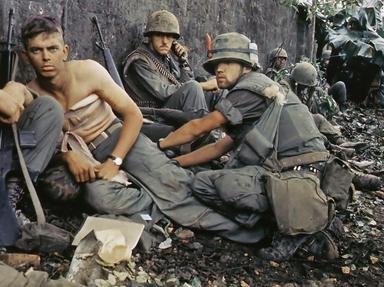Quiz Answer Key and Fun Facts
1. Well, there's just no place to start like the beginning. When did Viet Nam first break away from China to begin its tenuous venture as an independent country?
2. During WWII, after most of France was occupied by Germany, the French were obliged to give up their land holdings in what had become French Indochina. To what country did the spoils go?
3. After the decisive battle of Dien Bien Phu, the French made a decision to abandon their claims to Vietnam. Which leader of the Viet Minh opposition to both French and Japanese interests in the country got limited backing from China and the United States?
4. Hue, the nation's capital from 1802 until 1945, lay almost in the geographical center of the coastal region. During the Vietnam War, the city fell into which political zone of influence?
5. In what two ways was the A Shau Valley of importance to the North Vietnamese Army (VC)?
6. What was the worst case of a war crime perpetrated by Americans during the Vietnam War?
7. Lest we think that atrocities during the Vietnam War were confined only to Americans, which soldiers in 1965 during the battles at Ia Drang committed unspeakable acts of horror?
8. As an American, it is sometimes easy for me to view the post-French Vietnam War as involving only North and South Vietnamese soldiers along with U.S. advisors and troops; however, other nations also had a military presence in Vietnam.
Which other countries sent military troops to the region?
9. This man, a trusted confidante and younger brother of South Vietnamese President, Ngo Dinh Diem, was such an admirer of Adolf Hitler that he modeled the Can Lao secret police marching styles on Nazi marches and practiced torture methods based on Nazi examples. Who was he?
10. Which U.S. President finally declared an end to the war in Vietnam?
Source: Author
logcrawler
This quiz was reviewed by FunTrivia editor
bloomsby before going online.
Any errors found in FunTrivia content are routinely corrected through our feedback system.

